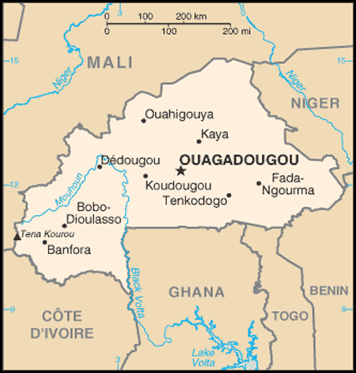- What We Do
- Agriculture and Food Security
- Democracy, Human Rights and Governance
- Economic Growth and Trade
- Education
- Ending Extreme Poverty
- Environment and Global Climate Change
- Gender Equality and Women's Empowerment
- Global Health
- Water and Sanitation
- Working in Crises and Conflict
- U.S. Global Development Lab
Situation

-
Climate change, land degradation, and slow economic development contribute to chronic food insecurity and malnutrition in households across Burkina Faso. Environmental shocks, including droughts and floods, further exacerbate food insecurity.
-
The 2012 coup d’état in neighboring Mali and rebel uprising in the north displaced hundreds of thousands of Malians. An estimated 32,000 refugees remain in Burkina Faso, placing additional strain on the food security of host communities.
-
According to the Famine Early Warning Systems Network (FEWS NET), stable staple food prices are contributing to Minimal (IPC Phase 1)* food insecurity for most households in Burkina Faso through September 2017. However, in Burkina Faso’s extreme northern region, FEWS NET expects Stressed (IPC Phase 2) acute food insecurity outcomes due to price increases for some commodities and the negative impact of insecurity on market function.
*The Integrated Food Security Phase Classification (IPC) is a standardized tool that aims to classify the severity and magnitude of food insecurity. The IPC scale, which is comparable across countries, ranges from Minimal—IPC I—to Famine—IPC 5.
Response
-
The Office of Food for Peace (FFP) targets food insecure Burkinabé and Malian refugees throughout Burkina Faso. FFP supports the UN World Food Program to respond to acute malnutrition and strengthen the resilience of vulnerable and food-insecure populations through targeted food distributions, food and cash for assets activities, supplementary feeding activities, and capacity building.
-
FFP supports the UN Children’s Fund (UNICEF) to provide ready-to-use therapeutic food to children suffering from severe acute malnutrition. UNICEF is also working to strengthen the technical capacity of Burkina Faso’s Ministry of Health staff through trainings and other activities at community, regional, and national levels.
-
FFP also partners with Catholic Relief Services and ACDI/VOCA to implement five year development programs with core interventions in the areas of agriculture and natural resource management, health and nutrition, and civil society strengthening. The programs focus on improving the nutritional status of the most vulnerable populations—including pregnant and lactating women and children under two—as well as improving agricultural production and productivity, and livelihoods diversification, including market linkages. Trainings on nutrition, hygiene, and sanitation best practices allow households to increase their consumption of nutritious foods, enhance dietary diversity, and increase the adoption of WASH best practices.
-
Through its programs, FFP collaborates with the USAID Resilience in the Sahel Enhanced (RISE) initiative.
Food for Peace Contributions
Total Contributions:
| U.S. Dollars | Metric Tons | |
|---|---|---|
| Fiscal Year 2017 | $1 million | 580 MT |
| Fiscal Year 2016 | $24.3 million | 1,490 MT |
| Fiscal Year 2015 | $11.1 million | 4,790 MT |
Fiscal Year 2017 Contribution Breakdown:
| U.S. Dollars | Metric Tons | |
|---|---|---|
| Title II Development | --- | ---- |
| Community Development Funds (CDF) | --- | ---- |
| Title II Emergency | $1 million | 580 MT |
| Emergency Food Security Program (EFSP) | --- | ---- |
Food Security Situation information provided by UNHCR, WFP and FEWS NET.
FY 2017 contribution based on funds obligated to date







Comment
Make a general inquiry or suggest an improvement.